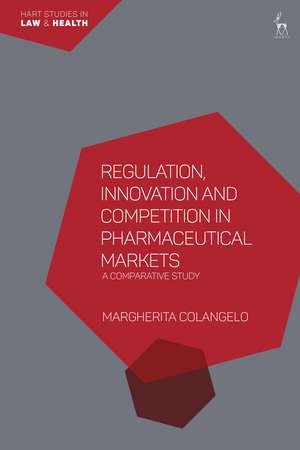Regulation, Innovation and Competition in Pharmaceutical Markets: A Comparative Study: Hart Studies in Law and Health
Autor Margherita Colangeloen Limba Engleză Hardback – 19 apr 2023
Preț: 511.07 lei
Preț vechi: 731.61 lei
-30% Nou
Puncte Express: 767
Preț estimativ în valută:
97.81€ • 101.73$ • 80.74£
97.81€ • 101.73$ • 80.74£
Carte tipărită la comandă
Livrare economică 14-28 aprilie
Preluare comenzi: 021 569.72.76
Specificații
ISBN-13: 9781509965519
ISBN-10: 1509965513
Pagini: 256
Dimensiuni: 156 x 234 mm
Greutate: 0.54 kg
Editura: Bloomsbury Publishing
Colecția Hart Publishing
Seria Hart Studies in Law and Health
Locul publicării:London, United Kingdom
ISBN-10: 1509965513
Pagini: 256
Dimensiuni: 156 x 234 mm
Greutate: 0.54 kg
Editura: Bloomsbury Publishing
Colecția Hart Publishing
Seria Hart Studies in Law and Health
Locul publicării:London, United Kingdom
Caracteristici
Taking a comparative approach, it draws on examples from the EU, US and the international framework
Notă biografică
Margherita Colangelo is Associate Professor of Comparative Law, Roma Tre University, Italy.
Cuprins
Acknowledgements vIntroduction 1I. The Different Faces of Pharmaceutical Markets 1II. Purpose and Scope of the Analysis 3III. Methodology 7IV. Structure of the Book 9PART I1. Regulating Entry 15I. The Main Features of Pharmaceutical Markets: The Supply Side and the Demand Side 15II. The Product Life Cycle and the Costs of Innovation 20III. The Access to the Market: Regulatory Approaches 23A. The European Regulatory Framework 23B. The US Regulatory Framework 27IV. Concluding Remarks 332. Regulating Exclusivity 34I. The Interplay between Regulatory Exclusivities and Intellectual Property Rights 34II. Intellectual Property Rights in the Pharmaceutical Industry: An Overview on the Role of Patents 35III. EU Supplementary Protection Certificate and US Patent Term Restoration 41IV. Regulatory Exclusivity 48V. Research and Bolar Exemptions 52VI. Exhaustion Doctrine and Parallel Trade 59VII. Concluding Remarks 633. Regulating Prices 64I. Pharmaceutical Pricing and Reimbursement Systems in Europe 64II. The US System 70III. Concluding Remarks 76viii ContentsPART II4. Competition Law Enforcement in Pharmaceutical Markets: An Introduction 79I. EU and US Antitrust Rules: An Essential Overview 79II. Antitrust Enforcement in the Pharmaceutical Sector 87III. Market Definition 95IV. Concluding Remarks 1005. Reverse Payment Patent Settlements 102I. The Recurrence of Reverse Payment Patent Settlements in Pharmaceutical Markets 102II. Reverse Payment Patent Settlements in the United States 105A. Earlier Case Law and the Actavis Ruling 105B. Critical Issues after Actavis 109C. Further Developments 113III. EU Case Law on Reverse Payment Patent Settlements 119A. Lundbeck 120B. Generics 123IV. Comparative Analysis 127A. Legal Frameworks 127B. The Antitrust Assessment 129V. Concluding Remarks 1346. Product Hopping 136I. Pharmaceutical Product Reformulations 136II. Product Hopping before US Courts 140III. The EU Experience 146IV. The Antitrust Assessment of Product Reformulation 151V. Concluding Remarks 1557. Excessive Drug Pricing 157I. The Resurgence of Excessive Pricing Cases in the Pharmaceutical Sector 157II. Excessive Pricing under EU Competition Law 161A. Aspen 165III. The US Approach 169IV. The Role of Antitrust Enforcement on Excessive Drug Prices 176V. Concluding Remarks 178Contents ixPART III8. Further Interactions: Pharmaceutical Markets, Intellectual Property and Human Rights 183I. The Right to Health and Access to Medicines and the Relationship with Intellectual Property Rights: An Overview 183II. Compulsory Licensing 191III. Concluding Remarks 1969. Public Health and Public Interest in Competition Law 198I. Public Health and Competition Law 198II. Competition Law and Non-competition Interests 203III. Concluding Remarks 208Conclusion 209Bibliography 213Index 233





